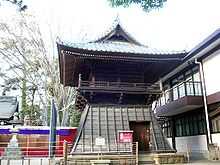Ōkunitama Shrine

Ōkunitama Shrine (大國魂神社 Ōkunitama Jinja) is a shrine located in Fuchu, Tokyo Japan. Six different shrines in Musashi province were consolidated and their gods enshrined here. Ōkunitama is now known as one of the five major shrines in Tokyo, the others being Tokyo Great Shrine (東京大神宮 Tōkyō Daijingū), Yasukuni Shrine, Hie Shrine and Meiji Shrine.
General description



Ōkunitama Shrine is said to have been founded in 111 by Emperor Keikō. It was here that Minamoto no Yoritomo prayed for his wife's safety during labour, while Minamoto no Yoriyoshi and Minamoto no Yoshiie prayed for victory against Mutsu Province.
The shrine's annual festival, Kurayami Matsuri, also appears on an informal list describing it as one of the Kanto region's three oldest festivals.
Within the shrine, there are many buildings and points of interest. Aside from the main shrine buildings, there are also seven smaller shrines. These are Matsuo Shrine, Tatsumi Shrine, Tōshōguu Shrine, Sumiyoshi Shrine, Ōwashi Shrine, Miyanome Shrine and an Inari shrine. You can also find a sumo ring and a Japanese-Russo War memorial, as well as the remains of the former Musashi provincial office.
Both smoking and riding bicycles are banned on shrine grounds.
Kurayami matsuri
The Kurayami matsuri (くらやみ祭り Darkness Festival) is claimed to be one of the three oddest festivals in Kanto region. This festival is held every year, between 30 April and 6 May. Originally this festival was described as an utagaki ( 歌垣 courtship song festival ).
Ryotaro Shiba, a Japanese essay writer and novelist, observed that this festival resulted in disorderly conduct by the participants.[1] He claimed that, amongst the single men and women who had gathered to sing and dance for each other, were also those who were married and who intended to have sex under cover of darkness. In the Meiji Era, facing criticism from Christian missionaries and visiting foreign educators and engineers, the authorities put a stop to this festival.
In its place, Kurayami Matsuri was created. Kurayami means 'darkness' and matsuri means 'festival' in Japanese. It was originally held during the night, but this was changed to evening in 1959.
On May 4, the road approaching the temple (Keyaki Namiki (ケヤキ並木 Elm Row)) is used as a track for horse-racing and performances of a masked folk dance known as Fuchuu Hayashi (府中囃子). On May 5, six large taiko drums lead eight mikoshi to a temporary holding area. They are returned to the shrine early in the morning the following day.
History
- 111(Established by Emperor Keikō in 41年)
- 111 founded 5 May
- 645(Taika)It became Saijyo of Kokuga (国衙) in Musashi, and it central shrine of Musashi.
- ? Six shrine was honored, the name called Musashi-sousha rikusho-guh.
- 1062: Minamoto no Yoriyoshi and his son, Minamoto no Yoshiie donated thousand of sapling of zelkova.
- 1182: Minamoto no Yoritomo made an invocation of his wife's safe delivery.
- 1186: Minamoto no Yoritomo build the shrine pavilions.
- 1590: Tokugawa Ieyasu donated 500 koku and build the shrine pavilions.
- 1646: the shrine pavilion was burned out.
- 1167: Tokugawa Ietsuna rebuilt the shrine pavilions.
- 1872: The name of shrine changed as Ohkunitama jinjya.
- 1875: It appointed as Fuken-sha .
- 1886: It appointed as Kanhei-shosha.
According to history of shrine, Keigyo tennoh (the 12th Mikado) established 5 May AD. 41. The offspring of Noomiame-no-hohino-mikoto (出雲臣天穂日命) appointed to Musashi Kuni no miyatsuko and rendered a service for shrine, successive miyatsukos have done same work. In Taika no kakushin at 645, Kokuhu of Musashi seted in this place, and Sha changed to Saijyo of Kokuga, and Kokushi render a service, it became the place sum up the Saimu in Japan.
See also
-
 Media related to Okunitama-jinja, Fuchu at Wikimedia Commons
Media related to Okunitama-jinja, Fuchu at Wikimedia Commons
List of Research papers for
Kurayami matsuri and Ohkunitama shrine
- 中里 亮平 2009 Matsuri boom and influence on festivals: the case of the kurayami-matsuri festival at Okunitama shrine in Fuchu, Tokyo. The Japanese folklore review (24), 47-60.
- 中里 亮平 2008 Festivals and Influential members of the community: the case of the Kurayami-matsuri Festival at Okunitama shrine in Fuchu-shi, Tokyo. The Japanese folklore review (23), 51-64.
- Tsuruga Eisuke 2007 Possibility on recovery of the humanity, concerned with festival reciprocity : Through the Fuchu Kurayami Matsuri researches. Education for sustainable development 6, 105-112.
- Mogi Sakae, Shimada Kiyoshi 1989 The Kurayami Matsuri at Okunitama Shrine in Fuchu Transaction of the institute for Japanese culture and classics 64, 140-207,
- 杉浦 翔子 2006 A study of the chief priest system of the plum wine drinking ritual held at Owari-no-Okunitama Jinja 『皇学館論叢』 39(6), 36-63,
- Koide Goro 1983 On Argonauta argo Housed in the Okunitama Shrine.『ちりぼたん』 14(1), 21.
Utagaki
- 糸永 正之 2009 Utagaki in Bhutan: the verification of face-to-face interaction through fixed-verse songs. Asian folk culture studies (8), 1-32.
- Nittamachi Yoshinao 1997 The Symbolism of The Expression in Touka. Research memoirs of the Kobe Technical College 35, 89-94.
- Miyazaki Takeshi 1997 A Study of a Traditional Event Utagaki in Tsugaru Area.7 『日本歌謡研究』 37, 73-83.
References
- ↑ 司馬遼太郎1964『燃えよ剣』
External links
- Official website (Japanese)
| ||||||||||||||||||||||||||||||||||||||||||||||||||||||
Coordinates: 35°40′02.4″N 139°28′44.4″E / 35.667333°N 139.479000°E